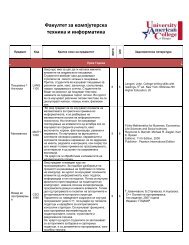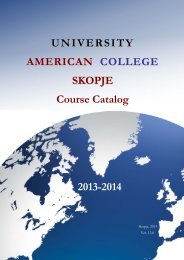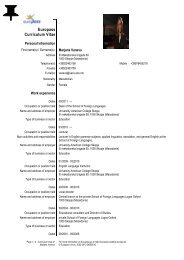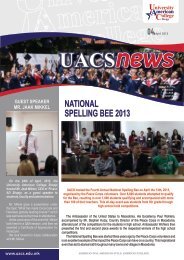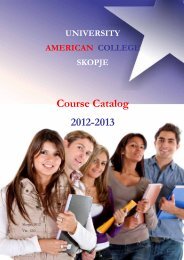UACS Collection of Abstracts 2011 - University American College ...
UACS Collection of Abstracts 2011 - University American College ...
UACS Collection of Abstracts 2011 - University American College ...
Create successful ePaper yourself
Turn your PDF publications into a flip-book with our unique Google optimized e-Paper software.
KeywordsJEL classificationAs illustration I will compare and discuss solutions <strong>of</strong>fered in Macedoniantranslations <strong>of</strong> English authors, especially Tolkien’s works, and Englishtranslations <strong>of</strong> Macedonian authors, concentrating on Slavko Janevski’s andVlada Uroshevic’s novels.Finally, the paper should bring deeper insight into best translationstrategies/practices when it comes to translating fantasy literature andmythological creatures.mythology, translation, mythological creatures, Tolkien, UroshevikjAuthor(s)Journal <strong>of</strong> paperappearanceConference <strong>of</strong> paperappearanceTitle <strong>of</strong> the paperAbstractKeywordsJEL classificationMarija TodorovaFrom Teaching to Learning, Current Trends in ELT, South‐East European<strong>University</strong>, Tetovo, 9‐ 11 April, 2010Learning to talk is learning to translateThe use <strong>of</strong> translation has been a fundamental part <strong>of</strong> language teachingsince the very beginning. Indeed, it must be the oldest language‐teachingtool <strong>of</strong> all. In his essay “Language and The Human Spirit”, Jim Cummins(2003) observes that “there is an inseparable linkage between theconceptions <strong>of</strong> language and human identity that we infuse in ourclassroom instruction.” Duff (1989: 7) summarizes succinctly: “Translationdevelops three qualities essential to all language learning: flexibility,accuracy, and clarity. It trains the learner to search (flexibility) for the mostappropriate words (accuracy) to convey what is meant (clarity).” Recentlywe have seen the use <strong>of</strong> translation in learning a foreign language is muchmaligned by language teachers. However, translation is widely used inlearners’ foreign language learning process. It appears that learners <strong>of</strong>tenuse translation as a learning strategy to comprehend, remember, andproduce a foreign language. Revisiting the pros and cons <strong>of</strong> usingtranslation (more precisely, the mother tongue) in the teaching andlearning <strong>of</strong> a foreign language, I will try to justifies the use <strong>of</strong> translation inthe English as a Foreign Language classroom and encourages thedevelopment <strong>of</strong> this as a useful fifth language skill. The use <strong>of</strong> L1, if usedproperly and judiciously, is a needful, and worthy, pedagogical ally in theteaching, and learning, <strong>of</strong> English language across all levels.Relatively little research attention so far seems to have been devoted to aconsideration <strong>of</strong> the use <strong>of</strong> translation in language learning. Thus, thispaper aims to inspire further research <strong>of</strong> the role <strong>of</strong> translation in ESLcontext, and promote cooperation between teachers <strong>of</strong> language and <strong>of</strong>translation.Translation, ELT, language skills27


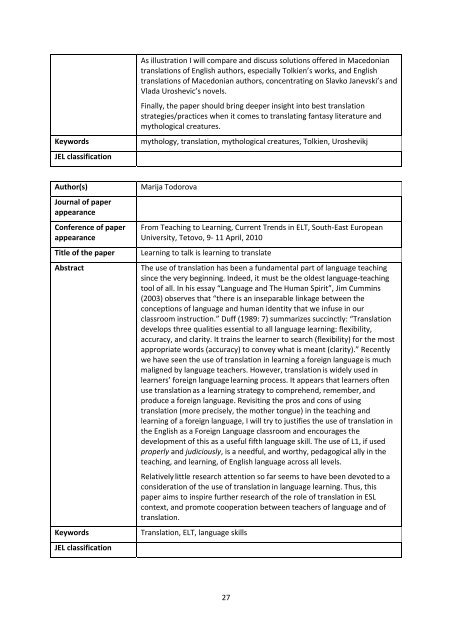
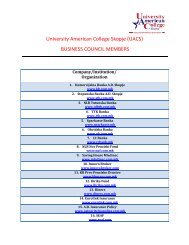

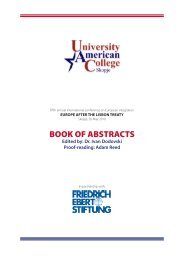

![amerikan kolex ]e bide prv univerzitet od treta generacija vo ...](https://img.yumpu.com/47278343/1/190x252/amerikan-kolex-e-bide-prv-univerzitet-od-treta-generacija-vo-.jpg?quality=85)

